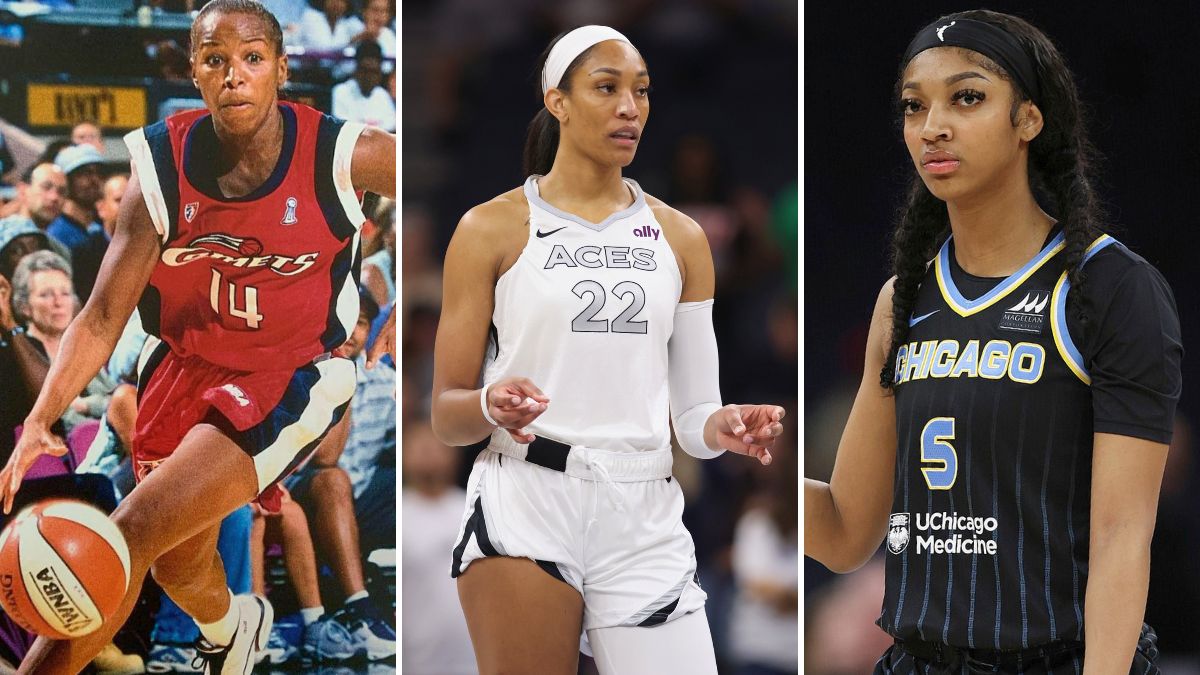Black Women WNBA Stars Past and Present Cynthia Cooper, A’ja Wilson, and Angel Reese (Photo Credits: Instagram, John Mac, Wikimedia Commons).
When you think of the WNBA, what do you envision? Is it the flashy style of play from the likes of Caitlin Clark? Or you could look to past legends like Sue Bird. But what about A’ja Wilson, a two-time MVP, or Tina Charles, who is ranked second all-time in scoring? For a league built by 65% black women, it’s time to ask why they haven’t been the faces we see in traditional sports media and marketing.
Since 1996, the WNBA has thrived primarily due to the contributions of Black women. Players like Sheryl Swoopes, Lisa Leslie, Tina Thompson and Cynthia Cooper essentially built the league that we see today. Cooper led the Houston Comets to four straight titles. Leslie was the first woman to dunk in a professional game. However, their names are rarely included in media conversations about the greatest to play in the W. This is mainly due to the media’s choice of who to spotlight, as well as the lack of media coverage.
Media Coverage Made Its Choice—And It Wasn’t Us
Instead, the media has elevated players like Sue Bird and Diana Taurasi, both of whom are undoubtedly talented but who have often received significantly more coverage, marketing and endorsement deals.
Bird and Taurasi, both white and longtime faces of USA Basketball, were heavily promoted throughout their careers, whether it be through their million-dollar deals with Nike, commercial appearances, or jersey sales.
Meanwhile, Cooper’s four titles were mainly celebrated within niche WNBA spaces and have yet to receive the same level of cultural significance within the sport. Despite her success in the league, Cooper never received any major national endorsements.
What Happens When Whiteness Shapes the Story
Coverage decisions have historically centered whiteness as more appealing, simultaneously, leaving the excellence of Black women overlooked. That framing is not only unfair but also inaccurate.
And it’s part of why so many of the Black women who shaped this league still aren’t household names.
“We can’t forget about our Black women athletes,” said veteran journalist Dawn Montgomery, who advocates for more inclusive sports media. “I think the reason why we saw Sue and Diana so much was because the media was intentional in platforming them. If we are more intentional in platforming our players, you’d have no choice but to see and hear them.”
A’ja Wilson Has Done Everything—But the Spotlight Still Skips Her
A’ja Wilson is arguably the best player in the league currently. With three MVPs, a DPOY title, and two championships, she’s checked every box for greatness. However, you wouldn’t know it from the national marketing, where Caitlin Clark received multiple endorsement deals before stepping foot onto a WNBA court, becoming the first athlete since Michael Jordan to have a signature basketball collection with the Wilson Sporting Goods brand.
Make no mistake, Clark is a phenomenal talent and extremely valuable to women’s basketball, but it’s worth asking why her arrival generated so much more buzz than Wilson’s dominant career.
It’s Not About Talent—It’s About Who Gets Seen
The Indiana Fever’s Caitlin Clark and the Minnesota Lynx’s Napheesa Collier (Photo Credit John Mac, Wikimedia Commons).
The disparity isn’t just about skill; it’s about visibility and who the media deems marketable. As stated previously, that has often meant white, conventionally feminine and non-threatening, a mold that America does not like to categorize Black women athletes.
“The front offices and media people did not look like us. They don’t know how to market us, they don’t know how to speak our language, as we’ve seen, and they don’t understand our culture,” Montgomery said.
However, things might be shifting.
Angel Reese Refuses to Be Anything But Herself
Signature energy. pic.twitter.com/8pGj3BFX5L
— Reebok (@Reebok) July 10, 2025
Along with Clark, one of the league’s brightest stars is the Chicago Sky’s Angel Reese, who embraces her identity regardless of what other media outlets have said about her.
“I’m a Black woman, and I’m going to stand in that. I’m going to lead with that. I’m not changing for anybody,” Reese once shared on “The Jennifer Hudson Show.”
She has quickly become the most-followed WNBA player on Instagram. Reese represents a new generation of Black women athletes who build platforms to highlight themselves. And incidentally, the wave of attention brought by Caitlin Clark has also drawn more attention to players like Reese and Wilson.
But if media narratives only uplift Black women as a byproduct of someone else’s spotlight, that’s not progress; that’s proximity.
It’s On Us to Shift the Narrative
The WNBA doesn’t suffer from a lack of talent, stories, or star power. What the league lacks is consistent media commitment to centering the Black women who make the league what it is.
This isn’t a new problem, but it’s one we can help fix. As viewers, we should support these women a lot more.
“I would like to challenge our Black newspapers to get some of our sports writers to find players or teams in or around your city and write a couple stories about some of the former players and former teams,” Montgomery added.
Because Black women have always been more than just background characters of the WNBA, they are the WNBA.
